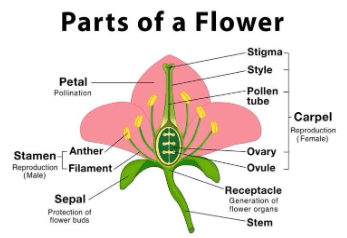Table of Contents
Double Fertilization is an important and unique feature in the cycle of reproduction of the angiosperms. It concerns the Fertilization process in the ovule of a flower through which two different sperm nuclei are transferred.
The first Fertilization results in the formation of zygote which gives rise to the embryo. The second Fertilization results in formation of the endosperm which is termed as triploid and plays the role of providing nutrients to the growing embryo.
This form of Fertilization guarantees the successful development of seeds hence it is important in the reproduction of angiosperms. The picture of double Fertilization not only reveals the secret of the formation of seeds, but it also explains the reason for evolutionary survival and diversification of angiosperms.
What is Angiosperm Reproduction?
Angiosperms possess elaborate reproductive organs and mechanisms in order to reproduce and perpetuate a particular species. The stamen contains pollen while the pistil contains ovule. Pollination forms the most important stage in Fertilization, since it is followed by the formation of pollen tubes, needed for the sustainment of the male gametes to the ovule in order to reproduce.
Let us discuss the sexual organs of a flowering plant.
Chief organs of reproduction
- Stamen (The Male Organ): The stamen synthesises pollen grains and it contains male gametophytes.
- Pistil (The Female Organ): The pistil contains an ovary with ovules that possess the female gametophytes.
The Fertilization process
- Pollination: The process of transfer of pollen grains from the stamen to the pistil is called pollination. It is the first phase of plant reproduction.
- Pollen tube formation:
- The pollen grain starts to grow on the stigma.
- This results in the formation of pollen tubes.
- The stamens open up in the middle, divided by the pollen tube.
- The pollen tube further extends towards the ovule.
- Double Fertilization:
- After pollination, the pollen tube grows down the style and into the ovule where double Fertilization takes place.
- Zygote formation: This process involves the uniting of one male gamete to form the zygote.
- Endosperm formation: The other male gamete fuses with the polar nuclei in the formation of the endosperm which is a nutritive tissue.
Also Check: External Fertilization
The Process of Double Fertilization
Double Fertilization starts with pollination and this involves the placing of pollen grains on the stigma of a flower. After a compatible pollen grain has stuck to the surface of the stigma it develops into a pollen tube which grows down the style towards the ovule. It contains two male gametes and it passes through the style towards the ovule situated in the ovary.
Below is the brief discussion of the Double Fertilization process.
Pollination and Pollen Tube Formation
- The pollen tube germinates in a directional manner and in this way gets oriented towards the ovule to provide the male gametes.
- The male gametophyte enters the ovule through a pore-like structure known as micropyle to penetrate into the embryo sac.
- The two male gametes are deposited in the embryo sac.
Fusion of Male and Female Gametes
- When one of the male gamete fuses with the female gamete or the egg cell, it results in the formation of diploid zygote that further develops in an embryo.
- This is when the first Fertilization or the syngamy takes place.
Second Fertilization
- When the second male gamete combines with two polar nuclei within the central cell of the embryo sac, the fusion creates the triploid endosperm.
- It is an organ of storage of foods that are used to support the embryo after germination.
- This is also called the Triple Fusion.
The two phenomena i.e., syngamy and triple fusion jointly constitute the larger phenomenon called double Fertilization.
Double Fertilization Diagram

Parts of a flowering depicting Male and Female reproductive parts
- Calyx- A group of sepals, usually green in colour.
- Corolla- A group of petals, brightly coloured except green
- Androecium- The male reproductive part of a flower consisting of the stamen having filament and anther.
- Gynoecium- The female reproductive part of a flower known as pistil or carpel consisting of stigma, style and ovary.
Significance of Double Fertilization
Double Fertilization is a significant process by which embryo and the endosperm is formed within the seed.
During the embryonic development the embryo turns into the new plant whilst the endosperm contains the nutrients.
Systematic usage of resource:
- The plant utilises the nutrient provided by the endosperm for its initial stages of development.
- This enables efficient use of resources. Thus, making sure that once the seed germinates, the chance of its survival is as high as possible.
The advantage of double Fertilization is that the embryo and its source of nutrients are produced simultaneously hence increasing the odds of seed formation.
FAQs on Double Fertilization
How does double Fertilization occur in angiosperms?
Double Fertilization takes place due to two sperm nuclei. One of the sperm nucleus fuses with the egg cell to form diploid zygote. While the other one fuses with the polar nuclei to form an endosperm.
What is the role of endosperm in seed?
The endosperm is the tissue which supplies food to the developing embryo until the seed germinates.
How is double Fertilization single from single Fertilization?
Double Fertilization leads to the formation of both zygote and endosperm while in single Fertilization the only resultant is the formation of zygote.
Where does double Fertilization take place?
Double Fertilization takes place in the ovule of the flower which is in the interior of the pistil or the carpellary structure.
What is the difference between double Fertilization and triple fusion?
Double Fertilization is a process in which one sperm gets into a nucleus of the egg cell and the other into the polar nuclei. Whereas in triple fusion, the second sperm cell fuses with the two polar nuclei to form the triploid endosperm.









